4-Methylumbelliferyl-N-acetyl-b-D-glucosaminide is widely utilized in research focused on:
- Enzyme Activity Assays: This compound serves as a substrate for various glycosidases, allowing researchers to measure enzyme activity in biological samples, which is crucial for understanding metabolic pathways.
- Cell Biology Studies: It is used in cell culture experiments to investigate the uptake and metabolism of glycosaminoglycans, providing insights into cellular functions and interactions.
- Diagnostic Applications: The compound can be employed in diagnostic tests for certain diseases, helping in the detection of enzyme deficiencies or abnormalities in glycosylation processes.
- Drug Development: In pharmaceutical research, it aids in screening potential drug candidates that target glycosylation-related pathways, which is vital for developing new therapies.
- Biotechnology: It is utilized in the production of recombinant proteins, enhancing the efficiency of glycosylation processes in biomanufacturing, thus improving product yield and quality.
General Information
Properties
Safety and Regulations
Applications
4-Methylumbelliferyl-N-acetyl-b-D-glucosaminide is widely utilized in research focused on:
- Enzyme Activity Assays: This compound serves as a substrate for various glycosidases, allowing researchers to measure enzyme activity in biological samples, which is crucial for understanding metabolic pathways.
- Cell Biology Studies: It is used in cell culture experiments to investigate the uptake and metabolism of glycosaminoglycans, providing insights into cellular functions and interactions.
- Diagnostic Applications: The compound can be employed in diagnostic tests for certain diseases, helping in the detection of enzyme deficiencies or abnormalities in glycosylation processes.
- Drug Development: In pharmaceutical research, it aids in screening potential drug candidates that target glycosylation-related pathways, which is vital for developing new therapies.
- Biotechnology: It is utilized in the production of recombinant proteins, enhancing the efficiency of glycosylation processes in biomanufacturing, thus improving product yield and quality.
Documents
Safety Data Sheets (SDS)
The SDS provides comprehensive safety information on handling, storage, and disposal of the product.
Product Specification (PS)
The PS provides a comprehensive breakdown of the product’s properties, including chemical composition, physical state, purity, and storage requirements. It also details acceptable quality ranges and the product's intended applications.
Certificates of Analysis (COA)
Search for Certificates of Analysis (COA) by entering the products Lot Number. Lot and Batch Numbers can be found on a product’s label following the words ‘Lot’ or ‘Batch’.
Número de catálogo
Número de lote/lote
Certificates Of Origin (COO)
This COO confirms the country where the product was manufactured, and also details the materials and components used in it and whether it is derived from natural, synthetic, or other specific sources. This certificate may be required for customs, trade, and regulatory compliance.
Número de catálogo
Número de lote/lote
Safety Data Sheets (SDS)
The SDS provides comprehensive safety information on handling, storage, and disposal of the product.
DownloadProduct Specification (PS)
The PS provides a comprehensive breakdown of the product’s properties, including chemical composition, physical state, purity, and storage requirements. It also details acceptable quality ranges and the product's intended applications.
DownloadCertificates of Analysis (COA)
Search for Certificates of Analysis (COA) by entering the products Lot Number. Lot and Batch Numbers can be found on a product’s label following the words ‘Lot’ or ‘Batch’.
Número de catálogo
Número de lote/lote
Certificates Of Origin (COO)
This COO confirms the country where the product was manufactured, and also details the materials and components used in it and whether it is derived from natural, synthetic, or other specific sources. This certificate may be required for customs, trade, and regulatory compliance.


